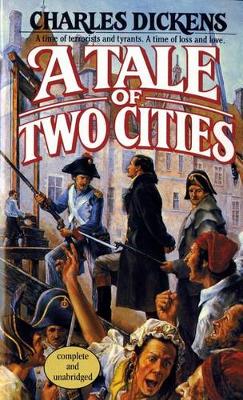What I enjoy most about Dickens is his prose. It might be hard to get into at first, but I just love his way with words. The beginning of this book is often referenced to, but it hasn't lost its power in the decades since it was written.
It was the best of times, it was the worst of times, it was the age of wisdom, it was the age of foolishness, it was the epoch of belief, it was the epoch of incredulity, it was the season of Light, it was the season of Darkness, it was the spring of hope, it was the winter of despair, we had everything before us, we had nothing before us, we were all going direct to Heaven, we were all going direct the other way - in short, the period was so far like the present period, that some of its noisiest authorities insisted on its being received, for good or for evil, in the superlative degree of comparison only.Hi, sentence that's a paragraph long, nice to meet you. Nineteenth century writing in general has a treacly quality, a slowness in words that can somehow convey lightness. Maybe I'm drifting off into poetics here, but truly, I enjoy how Dickens and many of his contemporaries write.
When I discussed A Tale of Two Cities with my professor, he commented that he disliked the artificialness of Dickens' stories. Every character that Dickens introduces will have an essential part in his story - and every characteristic that character has is there for a reason. When a regular story might be told to be "neatly tied up with a bow", Dickens is one of those creepy expert gift packers that will not only make the straightest bow you've ever seen, it's also knotted in such a way that instead of wanting to pull it open, you want to hang it on the wall and look at it because it's such a work of art. A Tale of Two Cities, though it relates the terror of the French Revolution incredibly well, isn't life-like. It is artificial. His use of literary devices like the double are only hidden in a thin layer of veneer, and his characters can hardly be called realistic.
However, he makes the absolute best non-realistic characters. I thought that nothing could top Miss Havisham from Great Expectations, until I met Ms Defarge, the woman who knits in code. Seriously though, how frigging awesome is that?
A Tale of Two Cities at times suffers from its grand scope - a lot of acceleration was necessary to span the time period Dickens wants to capture, and the time ellipses weren't always too conveniently placed. Minor annoyances and the occasional boring passage aside, A Tale of Two Cities is a great read for people who don't mind their stories being symmetrical and "neat".
